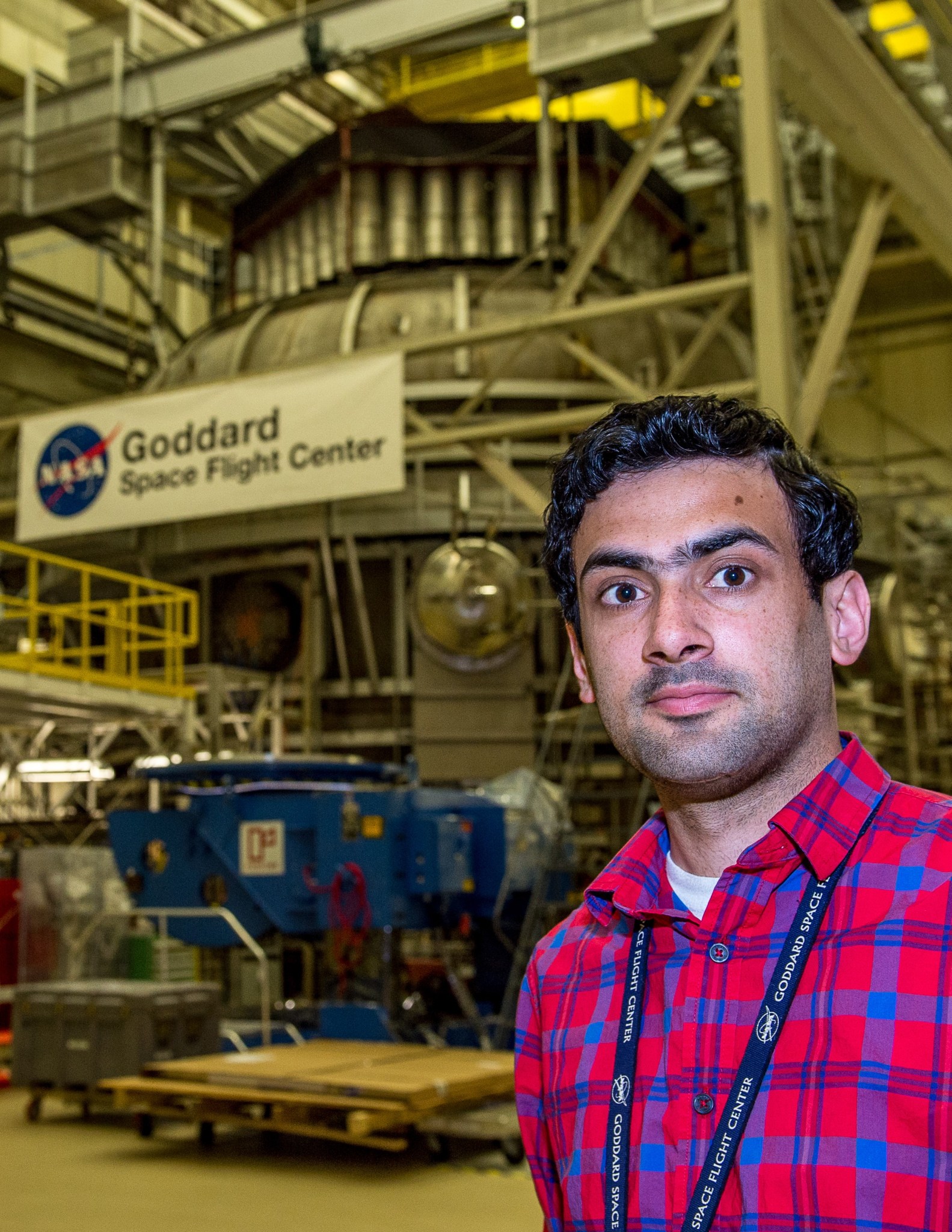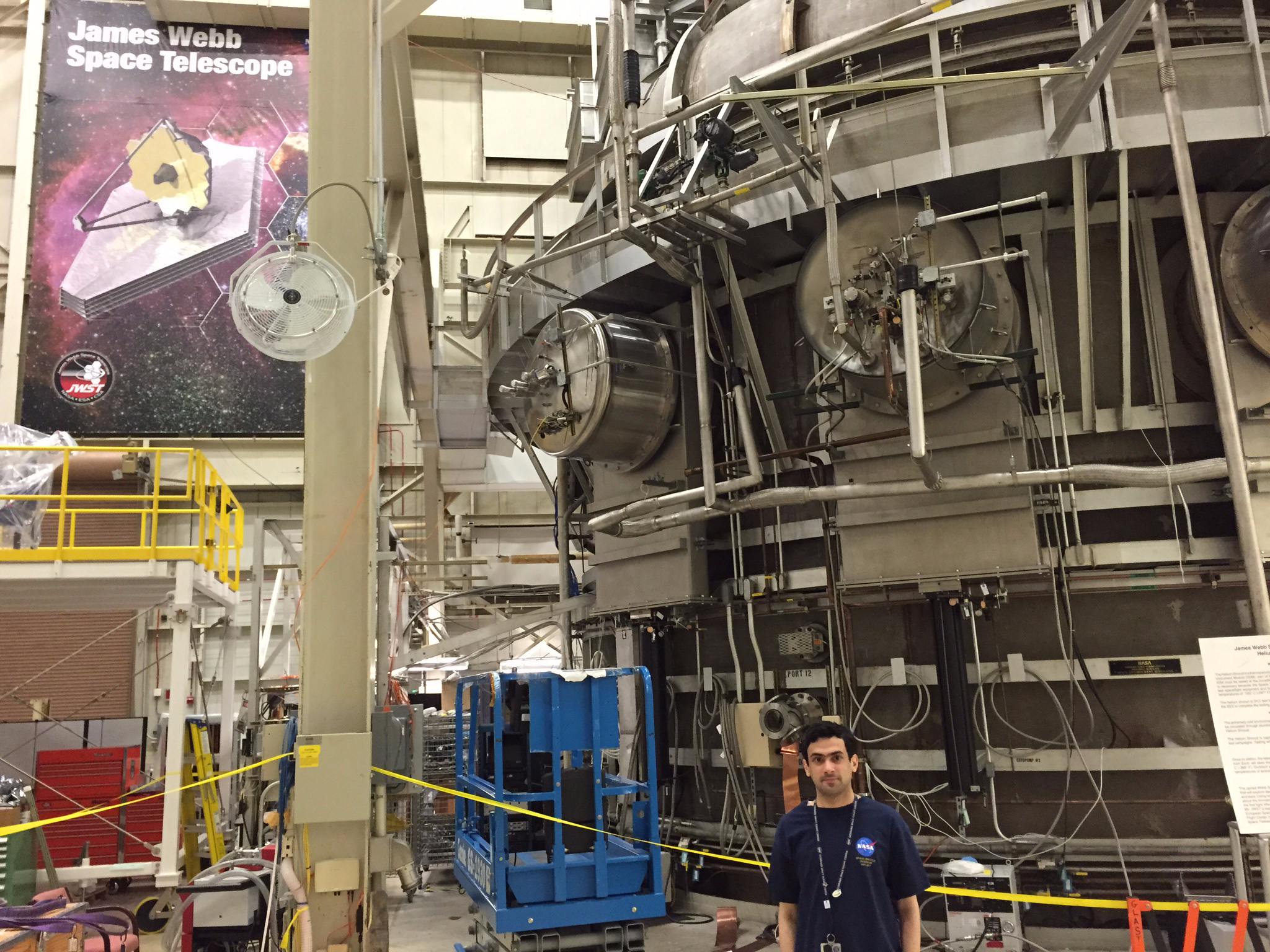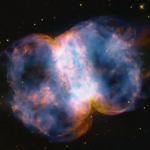Name: Yasir Tufail
Title: Aerospace engineer
Organization: Code 443, James Webb Telescope Office, Sciences Directorate
Integration and test engineer Yasir Tufail blows hot and cold.
What do you do and what is most interesting about your role here at Goddard? How do you help support Goddard’s mission?
I am an integration and testing operations engineer for the James Webb Telescope Integrated Science Instrument Module (ISIM), which consists of four instruments. We hope ISIM will detect the first light of the universe after the Big Bang, the formation of galaxies and the birth of stars.
I am also a test conductor for ISIM. I work with engineers and scientists to ensure that the module can withstand the harsh environment of space. When we conduct tests, we place the ISIM structure inside a special vacuum chamber and then, over several weeks and using nitrogen and helium tanks, lower the temperature to 40 kelvins or minus 387.67 F. This is cold beyond imagination!
How do you make sure that the instrument is working?
I work with operation team inside the ISIM Control Center (ICC), a huge room with different simulators used to communicate with the instruments when the ISIM is in the cyro chamber. Throughout the test, scientists come to the ICC to analyze the data. Each component of every instrument must function.
What happens during a test?
Tests generally run 24/7 for almost four months. We use rotating shifts of people to monitor. We have a huge list of all the tests we have to conduct so we know which engineers and scientists need to be present for each shift. During the test, we send commands to ISIM to see how well it responds. This all happens when ISIM is being kept extremely cold.
We will use these same commands once James Webb is launched. If these commands work in the cryo chamber, then they should work in space.
What does the team do if ISIM fails to respond to a command?
We have pages of telemetry mnemonics constantly giving us the health of the system, so we immediately know when a problem occurs. If so, we investigate the anomaly to find the root cause of the failure. We talk to the lead engineer for that particular piece of the system.
It takes several weeks to bring the cryo chamber back up to ambient temperature. If something is not going well, it is impossible to quickly turn off the cold. So we alternate incremental testing with implementing. After each test, we analyze and resolve each anomaly before starting the next test. It’s like solving a mystery.
What will you do after the ISIM testing is completed?
I will start working on the spacecraft side integrating parts with the James Webb spacecraft.
What is your background?
I was born in rural Pakistan where I lived until I was 13. My family then moved to Queens, New York. I am fluent in Urdu, Punjabi and Hindi. When my family gets together, we talk in Urdu, our national language.
What got you interested in space?
The Columbia accident was a turning point. One of the fallen astronauts was Kalpana Chawla, a civilian aerospace engineer educated in India. She inspired me.
I earned a degree in astronautical engineering from Capitol College, now Capitol Technology University, in Greenbelt, Maryland. During college, I worked with Space Operation Institute which allowed me to be a part of NASA’s missions. I loved it!
What’s the coolest thing you’ve done at Goddard?
Before joining James Webb, I was part of the Landsat-8 (LDCM) project. I started as a flight controller, but within six months I became the flight operation team lead for the propulsion subsystem. After LDCM successfully launched, the team used my flight scripts to command the spacecraft to prime propulsion system and fire small thrusters. I have no words to describe how excited I was!
Is there something surprising about you?
I love traveling and taking photos of landscapes. I plan to become a scuba diver and a pilot.
Where is your favorite place to go?
I go back to New York every other weekend. My favorite place is Central Park, where I love to watch the seasons change. It’s very close to my heart and it’s also the best place to be close to nature in New York City.
Of Note:
- NASA Landsat-8 Group Achievement Award, 2014
- JPL WISE Satellite appreciation Award, 2010
- Space Operation Institute Award, 2009
By Elizabeth M. Jarrell
NASA’s Goddard Space Flight Center, Greenbelt, Md.

Conversations With Goddard is a collection of Q&A profiles highlighting the breadth and depth of NASA’s Goddard Space Flight Center’s talented and diverse workforce. The Conversations have been published twice a month on average since May 2011. Read past editions on Goddard’s “Our People” webpage.































